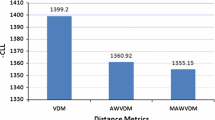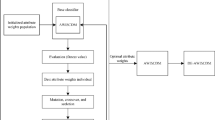Abstract
The value difference metric (VDM) is one of the best-known and widely used distance functions for nominal attributes. This work applies the instanceweighting technique to improveVDM. An instance weighted value difference metric (IWVDM) is proposed here. Different from prior work, IWVDM uses naive Bayes (NB) to find weights for training instances. Because early work has shown that there is a close relationship between VDM and NB, some work on NB can be applied to VDM. The weight of a training instance x, that belongs to the class c, is assigned according to the difference between the estimated conditional probability ^P(c|x) by NB and the true conditional probability P(c|x), and the weight is adjusted iteratively. Compared with previous work, IWVDM has the advantage of reducing the time complexity of the process of finding weights, and simultaneously improving the performance of VDM. Experimental results on 36 UCI datasets validate the effectiveness of IWVDM.
Similar content being viewed by others
References
Cover T M, Hart P E. Nearest neighbor pattern classification. IEEE Transactions on Information Theory, 1967, 13: 21–27
Aha D, Kibler D, Albert MK. Instance-based learning algorithms. Machine Learning, 1991, 6: 37–66
Domingos P. Rule induction and instance-based learning: a unified approach. In: Proceedings of the 14th International Joint Conference on Artificial Intelligence. 1995, 1226–1232
Frank E, Hall M, Pfahringer B. Locally weighted naive bayes. In: Proceedings of the 19th Conference on Uncertainty in Artificial Intelligence. 2003, 249–256
Mitchell T M. Machine Learning, 1st edition. McGraw-Hill, 1997
Tan P N, Steinbach M, Kumar V. Introduction to Data Mining, 1st edition. Pearson Education, 2006
Stanfill C, Waltz D. Toward memory-based reasoning. Communications of the ACM, 1986, 29: 1213–1228
Short R D, Fukunaga K. The optimal distance measure for nearest neighbour classification. IEEE Transactions on Information Theory, 1981, 27: 622–627
Myles J P, Hand D J. The multi-class metric problem in nearest neighbour discrimination rules. Pattern Recognition, 1990, 23: 1291–1297
Cost S, Salzberg S. A weighted nearest neighbor algorithm for learning with symbolic features. Machine Learning, 1993, 10: 57–78
Wilson D R, Martinez T R. Improved heterogeneous distance functions. Journal of Artificial Intelligence Research, 1997, 6: 1–34
Li C, Li H. One dependence value difference metric. Knowledge-Based Systems, 2011, 24: 589–594
Jiang L, Li C. An augmented value difference measure. Pattern Recognition Letters, 2013, 34: 1169–1174
Derrac J, Triguero I, García S, Herrera F. Integrating instance selection, instance weighting, and feature weighting for nearest neighbor classifiers by coevolutionary algorithms. IEEE Transactions On Systems, Man, and Cybernetics-Part B: Cybernetics, 2012, 42: 1383–1397
García-Pedrajas N. Constructing ensembles of classifiers by means of weighted instance selection. IEEE Transactions On Neural Network, 2009, 20: 258–277
Jahromi M Z, Parvinnia E, John R. A method of learning weighted similarity function to improve the performance of nearest neighbor. Information Sciences, 2009, 179: 2964–2973
Wang J, Neskovic P, Cooper L. Improving nearest neighbor rule with a simple adaptive distance measure. Pattern Recognition Letters, 2007, 28: 207–213
Kasif S, Salzberg S, Waltz D, Rachlin D J. A. A probabilistic framework for memory-based reasoning. Artificial Intelligence, 1998, 104: 287–311
Tian Y, Shi Y, Liu X. Recent advances on support vector machines research. Technological and Economic Development of Economy, 2012, 18: 5–33
Qi Z, Tian Y, Shi Y. Laplacian twin support vector machine for semisupervised classification. Neural Networks, 2012, 35: 46–53
Qi Z, Tian Y, Shi Y. Structural twin support vector machine for classification. Knowledge-Based Systems, 2013, 43: 74–81
Saar-Tsechansky M, Provost F. Active sampling for class probability estimation and ranking. Machine Learning, 2004, 54: 153–178
Jiang L, Zhang H. Learning naive bayes for probability estimation by feature selection. In: Proceedings of the 19th Canadian Conference on Artificial Intelligence. 2006, 503–514
Grossman D, Domingos P. Learning bayesian network classifiers by maximizing conditional likelihood. In: Proceedings of the 21st International Conference on Machine Learning. 2004, 361–368
Lowd D, Domingos P. Naive bayes models for probability estimation. In: Proceedings of the 22nd International Conference on Machine Learning. 2005, 529–536
Hall M. A decision tree-based attribute weighting filter for naive bayes. Knowledge-Based Systems, 2007, 20: 120–126
Witten I H, Frank E. Data Mining: Practical Machine Learning Tools and Techniques, 2nd edition. San Francisco: Morgan Kaufmann, 2005
Wilson D, Martinez T. Reduction techniques for exemplar-based learning algorithms. Machine Learning, 2000, 38: 257–286
Brighton H, Mellish C. Advances in instance selection for instancebased learning algorithms. Data Mining and Knowledge Discovery, 2002, 6: 153–172
Paredes R, Vidal E. Learning prototypes and distances: a prototype reduction technique based on nearest neighbor error minimization. Pattern Recognition, 2006, 39: 180–188
García S, Derrac J, Cano J R, Herrera F. Prototype selection for nearest neighbor classification: taxonomy and empirical study. IEEE Transactions On Pattern Analaysis and Machine Intelligence, 2012, 34: 417–435
Triguero I, Derrac J, García S, Herrera F. A taxonomy and experimental study on prototype generation for nearest neighbor classification. IEEE Transactions On Systems, Man, and Cybernetics, Part C: Applications and Reviews, 2012, 42: 86–100
Wu X, Kumar V, Quinlan J R, Ghosh J, Yang Q, Motoda H, Mclachlan G J, Ng A, Liu B, Yu P S, Zhou Z H, Steinbach M, Hand D J, Steinberg D. Top 10 algorithms in data mining. Knowledge and Information Systems, 2008, 14: 1–37
Jiang L, Wang D, Cai Z. Discriminatively weighted naive bayes and its application in text classification. International Journal on Artificial Intelligence Tools, 2012, 21(1): 1250007:1-1250007:19
Hall M A. Correlation-based feature selection for discrete and numeric class machine learning. In: Proceedings of the 17th International Conference on Machine Learning. 2000, 359–366
Jiang L, Zhang H, Cai Z. A novel bayes model: hidden naive bayes. IEEE Transactions on Knowledge and Data Engineering, 2009, 21: 1361–1371
Nadeau C, Bengio Y. Inference for the generalization error. Machine Learning, 2003, 52: 239–281
Kurgan L A, Cios K J, Tadeusiewicz R, Ogiela M, Goodenday L S. Knowledge discovery approach to automated cardiac spect diagnosis. Artificial Intelligence in Medicine, 2001, 23: 149–169
Author information
Authors and Affiliations
Corresponding author
Additional information
Chaoqun Li received her PhD from China University of Geosciences (Wuhan), China in June 2012. Currently, she is a lecturer in the Department ofMathematics, China University of Geosciences (Wuhan). Her research interests include data mining and machine learning. In these areas she has already published more than 10 papers in international journals such as Knowledge and Information Systems, Knowledge-Based Systems, International Journal of Pattern Recognition and Artificial Intelligence, Pattern Recognition Letters, and the Journal of Experimental & Theoretical Artificial Intelligence.
Liangxiao Jiang received his BS, MS, and PhD from China University of Geosciences (Wuhan), China in June 2001, 2004, and 2009 respectively. He joined the Department of Computer Science, China University of Geosciences (Wuhan) as an assistant in July 2004, and at present he is a professor. He has wide research interests, including data mining and machine learning.
Hongwei Li received his PhD in Applied Mathematics from Peking University, China, in 1996. From July 1996 to July 1998, he was a postdoctoral fellow with the Institute of Information Science, Beijing Jiaotong University, China. Since 1999, he has been a professor at the School of Mathematics and Physics, China University of Geosciences (Wuhan), China. His research interests include pattern recognition, statistical signal processing, blind signal processing, multidimensional signal processing, and time series analysis.
Rights and permissions
About this article
Cite this article
Li, C., Jiang, L. & Li, H. Naive Bayes for value difference metric. Front. Comput. Sci. 8, 255–264 (2014). https://doi.org/10.1007/s11704-014-3038-5
Received:
Accepted:
Published:
Issue Date:
DOI: https://doi.org/10.1007/s11704-014-3038-5




